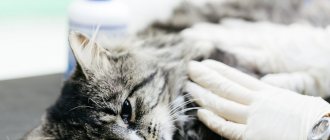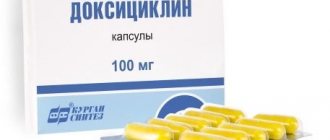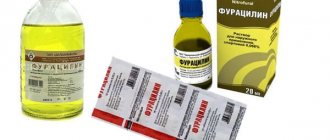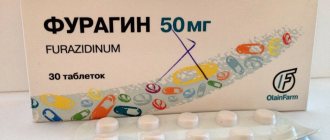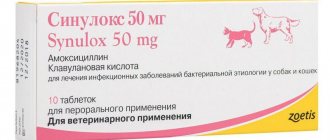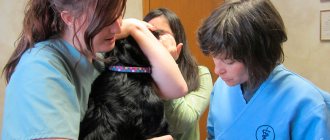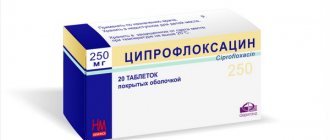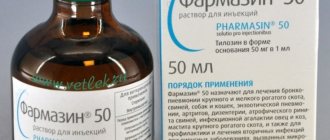Ceftriaxone dosage for cats
According to the instructions for use, the dose of ceftriaxone for cats is 25 mg/kg 2 times a day for 5-7 days, intravenously, intramuscularly.
Ceftriaxone 1.0 grams + 5 ml saline solution. 1 ml contains 200 mg of ceftriaxone, which should be used in cats weighing 8 kg.
Table 1 - Dosing of ceftriaxone for cats (1 g bottle + 5.0 ml of solvent) when prescribing the drug 2 times a day (dose 25 mg/kg body weight)
| Weight, kg | Dose, mg | Volume of the drug in ml |
| 0,5 | 12,5 | 0,063 |
| 1 | 25 | 0,125 |
| 2 | 50 | 0,25 |
| 3 | 75 | 0,375 |
| 4 | 100 | 0,5 |
| 5 | 125 | 0,625 |
| 6 | 150 | 0,75 |
| 7 | 175 | 0,875 |
| 8 | 200 | 1,0 |
Table 2 - Dose of ceftriaxone for cats (1 g bottle + 5.0 ml of solvent) when the drug is prescribed once a day (dose 50 mg/kg body weight)
| Weight, kg | Dose, mg | Volume of the drug in ml |
| 0,5 | 25 | 0,125 |
| 1 | 50 | 0,25 |
| 2 | 100 | 0,5 |
| 3 | 150 | 0,75 |
| 4 | 200 | 1 |
| 5 | 250 | 1,25 |
| 6 | 300 | 1,5 |
| 7 | 350 | 1,75 |
| 8 | 400 | 2,0 |
The main route of administration is intravenous and intramuscular. Many veterinarians use the drug subcutaneously. No adverse reactions were noted. Intramuscular injections are painful. With rapid intravenous administration - vomiting.
Features of use in cats
In order for the treatment to be effective and safe, it is very important to properly dilute the Ceftriaxone powder, thus preparing an injection solution. And it is precisely at this important stage that some confusion and inconsistency arise. This, in my opinion, is due to the fact that Ceftriaxone is a drug originally intended for the treatment of people, and instructions for its use were developed accordingly.
Veterinary Ceftriaxone is no different from regular
According to the instructions, the powder should be diluted with Lidocaine in order to relieve the pain of Ceftriaxone administration. But the fact is that Lidocaine is not safe for cats, and is sometimes even used to euthanize them. Veterinarians report many cases of pet deaths after the administration of Lidocaine - such sad stories have happened to my friends. Novocaine as an alternative to Lidocaine is also not a good option, since it reduces the effectiveness of the therapeutic effects of Ceftriaxone. Many veterinarians prefer not to take risks and do without pain relief at all - prepare a Ceftriaxone solution in water for injection or even in saline solution. According to my observations, sometimes this can actually be a solution - if the animal is patient with pain.
But most cats are still endowed with increased sensitivity, and severe pain from an injection creates additional stress for them, which cannot in any way contribute to recovery. How to do the right thing to help and not harm your pet? This debatable question requires not an unambiguous answer, but a compromise:
- Do not do the first injection yourself, but under the supervision of a veterinarian, who will be able to provide urgent qualified assistance in the event of the manifestation and development of unwanted symptoms.
- Ask your doctor to conduct a skin test before the injection (rubbing the prepared Ceftriaxone solution into a small scratch on the inside of the cat’s thigh), which will quickly demonstrate the animal’s reaction not only to Lidocaine, but also to the main drug.
- Carefully adhere to the dosages of Ceftriaxone recommended specifically for your pet, do not exceed them, and immediately seek medical help at the first sign of an allergy or other side effects.
Selection of doses and treatment regimen
At first glance, calculating and preparing a medicine for administration may seem very complicated, especially since an error in the proportions of the solution is unacceptable. Having decided on the choice of solvent, you need to dilute the powder from a one-gram bottle with 4 ml of liquid (2 ml each of water for injection and anesthetic) and shake the mixture well. In this way, the optimal concentration of Ceftriaxone will be obtained - 250 mg per milliliter of solution.
Ceftriaxone is diluted in a vial from a syringe
A single dose is usually calculated more simply: cats that weigh less than two kilograms are given 0.5 ml of the prepared solution; for cats whose weight exceeds two kilograms - 1 ml of medicine.
The treatment course of Ceftriaxone usually lasts from one to two weeks. The injections are given at the same time with an interval of 24 hours; sometimes the doctor may advise dividing the daily dose into two injections. Do not self-medicate: it can be disastrous for your pet. Only a veterinarian, based on an accurate diagnosis, has the right to prescribe a drug, determine the schedule and duration of injections.
Video: how to properly make a solution from powder for injection
Is it possible to give a cat an injection yourself?
Ceftriaxone is infused intravenously or intramuscularly. Sometimes veterinarians may recommend subcutaneous injections, but this is the exception rather than the rule. The drug should be administered intravenously very slowly, and it is better to entrust this not the simplest procedure to specialists. But every owner is quite capable of giving intramuscular injections to their cat - this simple skill can save your pet not only health, but also life.
Pharmacokinetics
The pharmacokinetic properties of ceftriaxone, a third generation cephalosporin, were studied in five cats.
after a single intravenous, intramuscular and subcutaneous administration at a dose of 25 mg/kg. Ceftriaxone MICs have been determined for some Gram-positive and negative strains isolated from clinical cases.
The predictor of efficacy (t>MIC) was also calculated. Serum distribution of ceftriaxone was best fit in two-component and single-component open-label models with first-order elimination after intravenous and intramuscular and subcutaneous administration, respectively. After intravenous administration, distribution was rapid (t1/2d 0.14 ± 0.02 h) and moderate, as reflected in the volume of distribution (Vd (cc)) 0.57 ± 0.22 l/kg. In addition, elimination was rapid with plasma clearance of 0.37 ± 0.13 L/h•kg and t1/2 of 1.73 ± 0.23 h. Peak serum concentration (Cmax), tmax, and bioavailability for intramuscular administration were 54 .40 ± 12.92 μg/ml, 0.33 ± 0.07 h and 85.72 ± 14.74%, respectively; and for the subcutaneous route the same parameters were 42.35 ± 17.62 μg/ml, 1.27 ± 0.95 h and 118.28 ± 39.17%. The MIC of ceftriaxone for gram-negative bacteria ranged from 0.0039 to >8 μg/ml, and for gram-positive bacteria from 0.5 to 4 μg/ml t>MIC ranged from 83.31–91.66% (10–12 h) from the recommended dosing interval (12 h) for E. coli (MIC90 = 0.2 μg/ml).
general description
Ceftriaxone is available in the form of a white or yellowish powder. For its packaging, glass bottles are used, which are sealed with rubber stoppers and closed with aluminum caps. They allow you to maintain the tightness of the drug. Since the drug is used in the form of injections, the powder is diluted with water for injection or novocaine before use. 0.25, 0.5, 1 or 2 g of ceftriaxone sodium salt is placed in the vials.
Containers with powder are packaged in cardboard boxes of 10 pieces, but in many pharmacies they are sold individually. The shelf life of unopened bottles is 3 years from the date of production if stored away from sunlight at a temperature of 15 to 25 degrees Celsius. The prepared solution cannot be stored.
Important! The antibiotic should not be used after the expiration date, so always pay attention to the date on the package.
Warnings/Precautions
According to the instructions for use of ceftriaxone for cats, the presence of an allergy to penicillin or another beta-lactam antibiotic should alert the veterinary medicine physician
to carry out a skin prick test. Discontinue if sonographic signs or symptoms of urolithiasis or oliguria occur. Renal failure in cats: monitoring; reduce dose if drug accumulation occurs. Chronic liver disease or nutritional dystrophy (impaired synthesis or storage of Vitamin K): monitor prothrombin time. Both hepatic and significant renal impairment: usually maximum 50 mg/kg/day. Ensure adequate hydration.
Contraindications and side effects
Ceftriaxone is a potent antibiotic, but has a small number of contraindications:
- severe renal and hepatic dysfunction;
- ulcerative lesions of the stomach and intestines;
- individual hypersensitivity to cephalosporin antibiotics.
Ceftriaxone is prescribed with caution for any disorders of the urinary system, since the active substance of the drug is partially excreted by the kidneys. The product has a pronounced teratogenic effect, so it is prohibited for use in pregnant and lactating females, as well as in kittens. At least 3 months must pass from the moment of treatment with Ceftriaxone until the animal is mated, otherwise the risk of negative effects on the offspring remains.
Ceftriaxone is contraindicated for use in kittens.
Ceftriaxone is usually well tolerated by the body, but sometimes the following undesirable effects may develop:
- disorders of the digestive system (vomiting, diarrhea, lack of appetite, flatulence);
- allergic manifestations;
- bronchospasm;
- itching, urticaria, hair loss;
- disorders of the kidneys and liver;
- changes in blood test results (decrease in the concentration of leukocytes, lymphocytes, etc.).
Side effects develop especially often in weakened and elderly animals, so they require special monitoring during treatment. At the site of injection of the solution, slight swelling or infiltration may be observed, which usually resolve on their own and do not require medical intervention.
Important! If, 2-3 days after the start of therapy, the cat does not show any improvement or serious side effects are observed, you should consult a doctor as soon as possible and replace the drug with another antibiotic.
Mechanism of resistance
Resistance to ceftriaxone is primarily due to hydrolysis of the antibiotic by beta-lactamase, changes in penicillin-binding proteins and a decrease in bacterial cell permeability.
Interactions with other antimicrobials In an in vitro study, antagonistic effects were observed with the combination of chloramphenicol and ceftriaxone.
Ceftriaxone has been shown to be active against most isolates of the following bacteria, both in vitro and in clinical studies in cats, as described in the INDICATIONS AND USAGE section of the instructions for use:
Ceftriaxone is effective against gram-negative bacteria, causative agents of infections in cats:
- Acinetobacter calcoaceticus
- Enterobacter aerogenes
- Enterobacter cloacae
- Escherichia coli
- Haemophilus influenzae
- Haemophilus parainfluenzae
- Klebsiella oxytoca
- Klebsiella pneumonia
- Moraxella catarrhalis
- Morganella Morgania
- Neisseria gonorrhoeae
- Neisseria meningitidis
- Proteus mirabilis
- Proteus vulgaris
- Pseudomonas aeruginosa
- Serratia Marcescens
How it works and when to use it
Ceftriaxone is a third-generation antibiotic from the cephalosporin series. The principle of its action is that it prevents the synthesis of cell membranes in pathogenic microorganisms. As a result of this action, the microbes die. The antibiotic begins to act 2-3 hours after introduction into the body. Together with the bloodstream, it spreads throughout the body and is excreted mostly by the kidneys.
The drug is effective against various bacterial infections:
- staphylococcus;
- streptococci;
- coli;
- proteas;
- enterococcus;
- salmonella, etc.
Treatment of cats with Ceftriaxone is recommended in the following cases:
- with otitis;
- for sepsis;
- for bronchitis, pneumonia and other infectious diseases of the respiratory tract;
- for cystitis and other bacterial inflammations of the genitourinary system;
- when affected by infection of the liver and biliary tract;
- with chladimiosis;
- with meningitis;
- for osteomyelitis and other bone pathologies of bacterial origin;
- for infectious inflammation of soft tissues;
- for gastrointestinal infections;
- for other pathologies caused by antibiotic-sensitive microorganisms.
The medicine is also prescribed in the postoperative period to prevent complications in the form of bacterial infections.
Release form and properties of the drug
The drug is included in the category of 3rd generation cephalosporin antibiotics. Its active substance inhibits the viability and development of many pathogenic strains of bacteria. The medication has a long-lasting and pronounced effect.
The active ingredient of the drug is ceftriaxone in the form of sodium salt. The medicine is available in the form of a powdered substance, from which a suspension is prepared for intramuscular administration. The product is placed in bottles of 500, 250 or 1000 mg. Before diluting the medication with lidocaine or novocaine, you should read the instructions and consult a doctor.
Analogs
The product is so effective due to its active ingredient that analogues have appeared. Replace the medication only if you are intolerant or unable to give an injection. Anyway, ceftriaxone powder is considered the most effective antimicrobial agent.
global $ads_google; //data-ad-slot=”2475549904″ $ads_google = empty($ads_google) ? false : true; ?> if ($ads_google == false) {?>
$ads_google = true; ?> } ?>
Drug analogues:
- amoxicillin: tablets or injections, the effect of the drug is milder, but just as effective;
- Cephalexin: allowed for the treatment of pregnant cats, but requires medical supervision. This product is in capsules;
- sorcef: a convenient antimicrobial agent available in powder form for suspension and in tablet form. The activity is not as high as that of ceftriaxone;
- doxycycline: the medicine is not suitable for cats expecting offspring, as well as for kittens or cats that have a disorder of the musculoskeletal system.
How to give a cat an injection correctly
To prevent the development of infection after sterilization and for certain diseases, veterinarians often prescribe Ceftriaxone. The owners of the house have to give injections to the cat, this saves time and money on a daily visit to the clinic. But not everyone knows how to give injections. The basic rules are the same as for injections for people: sterility, adherence to the exact dosage, and others. But there are some special features for cat injections.
- "Ceftriaxone" is administered to the pet intramuscularly. It is best to do this at the back of the thigh. You need to make sure that the animal’s muscles are not tense; to do this, calm the cat down and massage its paw.
- There is no need to lubricate the animal's skin with alcohol, since cats have an antibacterial layer on it. The main thing is that there is no inflammation or dirt at the injection site. And you should not touch the needle with your hands.
- It is better to use a thin insulin syringe to administer the drug. It holds just 1 ml. This is exactly how much Ceftriaxone solution is needed for large animals. This syringe is better because it has a thin needle. This injection is already painful, but with a thick needle it will be even worse.
- It is better to have someone hold the cat during the procedure. The injection must be done with clear, confident movements, and try to finish everything quickly.
Reviews about the use of the drug "Ceftriaxone"
Many owners of furry pets write that this antibiotic saved their pet from a serious infection. Basically, Ceftriaxone is prescribed after sterilization operations. The owners note that this medicine helped to avoid complications, the wound healed quickly, and there was no pus. Many animals tolerate the drug without side effects; the only drawback of these injections is that they are very painful to install. But there are also reviews that note that the cat developed a severe allergic reaction, vomiting or impaired kidney function. If you do not pay attention to side effects after the first injection, the animal may die.
Source fb.ru
Side effects after using the drug
Ceftriaxone for cats is often prescribed by veterinarians, but not all animals tolerate this drug. Many people experience serious disruptions in the functioning of many organs and systems when using it. The following side effects may occur:
- nausea and vomiting;
- flatulence, constipation, intestinal upset;
- allergic reactions, urticaria;
- difficulty breathing, bronchospasm;
- dysfunction of the liver and kidneys;
- deterioration of blood composition;
- problems with the urinary system;
- fungal diseases;
- headaches, dizziness.
Advantages and disadvantages
The advantages of using Ceftriaxone for cats include high efficiency, rapid positive results, a wide spectrum of action and the availability of an antibacterial drug. You can purchase the medicine at any pharmacy, spending no more than 30 rubles per bottle. Ceftriaxone also has disadvantages: AB injections are painful, a high risk of developing side symptoms, the likelihood of death when a large amount of suspension is administered, difficulty in preparing the solution and a list of contraindications.
